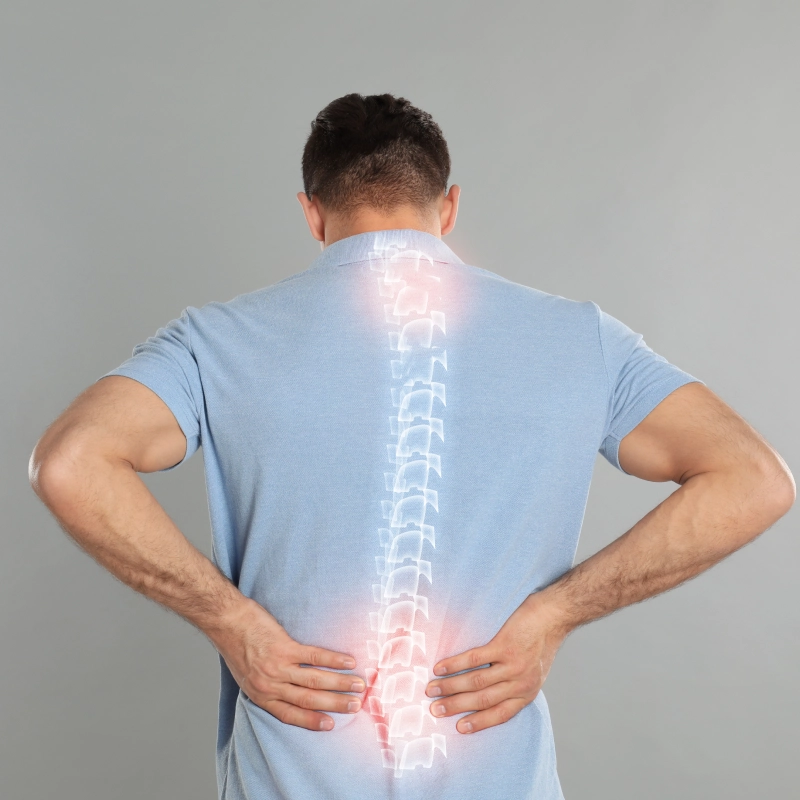
The human spine, comprising 33 vertebrae, intricate muscles, and resilient ligaments, serves as the central support for the body and facilitates a wide range of movements. Disorders affecting the spine, such as herniated discs or scoliosis, can lead to severe pain, reduced mobility, and diminished overall well-being, affecting daily activities and overall quality of life.
What are Spine Diseases?
Spine diseases refer to a variety of conditions that affect the spine, leading to pain, discomfort, and mobility issues. The spine, composed of vertebrae, discs, nerves, and the spinal cord, is a complex structure that provides support and flexibility to the body. When any part of this structure is compromised, it can result in significant health problems.
Common Types of Spine Diseases
- Herniated Disc: A herniated disc occurs when the inner gel-like core of a spinal disc protrudes through its outer layer. This condition can press on nearby nerves, leading to pain, numbness, or weakness in the arms or legs.
- Spinal Stenosis: Spinal stenosis involves the narrowing of the spinal canal, which can compress the spinal cord and nerves. This condition often results from degenerative changes and can cause pain, numbness, and muscle weakness.
- Scoliosis: Scoliosis is a lateral curvature of the spine that usually develops during childhood or adolescence. While mild cases may not cause symptoms, severe scoliosis can lead to back pain, respiratory issues, and noticeable deformity.
- Degenerative Disc Disease: Degenerative disc disease is a condition where the spinal discs lose their flexibility and height over time. This can result in pain, stiffness, and reduced range of motion.
- Osteoporosis: Osteoporosis weakens the bones, making them more susceptible to fractures. Spinal fractures due to osteoporosis can cause significant pain and a hunched posture.
- Spinal Tumors: Spinal tumors can be benign or malignant and can develop within the spinal cord, the surrounding tissues, or the vertebrae. Symptoms include pain, neurological deficits, and, in severe cases, paralysis.
Causes of Spine Diseases
Spine diseases can be caused by various factors, including:
- Aging: Natural wear and tear on the spine can lead to degenerative changes.
- Injury: Trauma from accidents or falls can damage the spine.
- Genetics: Some spine conditions, like scoliosis, can run in families.
- Lifestyle Factors: Poor posture, obesity, and lack of exercise can contribute to spine problems.
- Infections: In rare cases, infections can affect the spine.
- Tumors: Both benign and malignant tumors can develop in the spine.
Symptoms of Spine Diseases
The symptoms of spine diseases vary depending on the specific condition but commonly include:
- Pain: Localized or radiating pain in the back, neck, arms, or legs.
- Numbness: Loss of sensation, often in the extremities.
- Weakness: Muscle weakness affecting mobility and dexterity.
- Stiffness: Reduced flexibility and difficulty in movement.
- Deformity: Visible curvature or abnormal posture of the spine.
- Neurological Issues: Problems with balance, coordination, and bladder or bowel control.
Risk Factors of Spine Diseases
Risk factors for spine diseases include:
- Aging: Degenerative changes in the spine, like disc degeneration and arthritis, increase with age.
- Genetics: Family history of spine disorders can predispose individuals to similar conditions.
- Obesity: Excess weight puts additional stress on the spine and discs, leading to potential problems.
- Poor Posture: Prolonged poor posture can lead to spinal misalignments and strain.
- Sedentary Lifestyle: Lack of exercise weakens the muscles supporting the spine, making it more susceptible to injury.
- Repetitive Stress: Jobs or activities involving repetitive bending, lifting, or twisting can strain the spine and lead to disorders.
- Injuries: Previous spinal injuries or trauma can increase the risk of future spine problems.
- Smoking: Smoking reduces blood flow to spinal tissues, impeding healing and increasing the risk of degenerative diseases.
Diagnosing Spine Diseases
Diagnosing spine diseases typically involves a combination of medical history, physical examination, and imaging studies. Common diagnostic tools include:
- X-rays: To identify bone abnormalities and fractures.
- MRI (Magnetic Resonance Imaging): Provides detailed images of soft tissues, including discs, nerves, and spinal cord.
- CT (Computed Tomography) Scans: Offers detailed cross-sectional images of the spine.
- Electromyography (EMG): Measures the electrical activity of muscles to detect nerve damage.
- Bone Density Tests: Used to diagnose osteoporosis.
Treatment Options for Spine Diseases
The treatment for spine diseases varies based on the condition's severity and the patient's overall health. Options include:
- Conservative Treatments
- Medication: Pain relievers, anti-inflammatory drugs, and muscle relaxants can help manage symptoms.
- Physical Therapy: Exercises to strengthen muscles, improve flexibility, and reduce pain.
- Lifestyle Modifications: Weight management, ergonomic adjustments, and quitting smoking.
- Minimally Invasive Procedures
- Epidural Steroid Injections: Reduce inflammation and pain in specific areas.
- Nerve Blocks: Temporary relief by blocking pain signals.
- Surgical Interventions
- Discectomy: Removal of herniated disc material.
- Laminectomy: Removal of part of the vertebra to relieve pressure on the spinal cord.
- Spinal Fusion: Joining two or more vertebrae to stabilize the spine.
- Vertebroplasty/Kyphoplasty: Injection of bone cement to stabilize fractures.
- Alternative Therapies
- Chiropractic Care: Manual adjustments to improve spinal alignment.
- Acupuncture: May help reduce pain and improve function.
Conclusion
Spine diseases encompass a range of conditions that can affect the structure and function of the spine, leading to pain, disability, and decreased quality of life. Early diagnosis and appropriate treatment are crucial for managing these conditions effectively. If you experience persistent back or neck pain, numbness, or weakness, consult a healthcare professional to determine the cause and explore the best treatment options. With proper care, many individuals with spine diseases can lead active and fulfilling lives.

